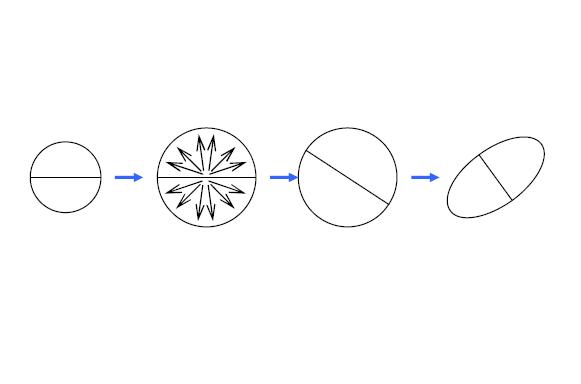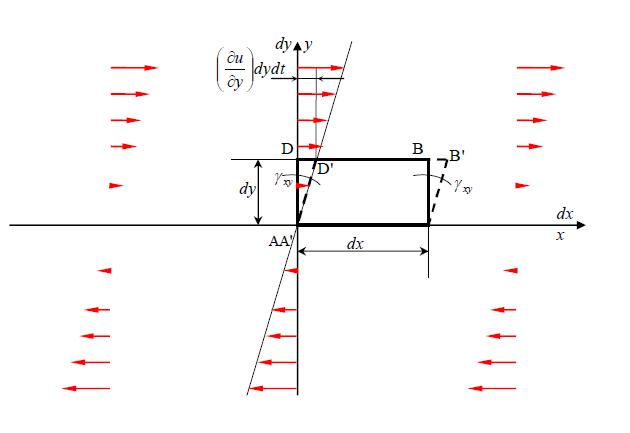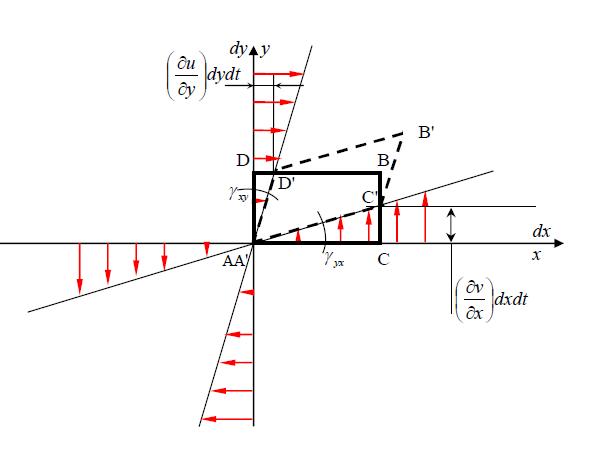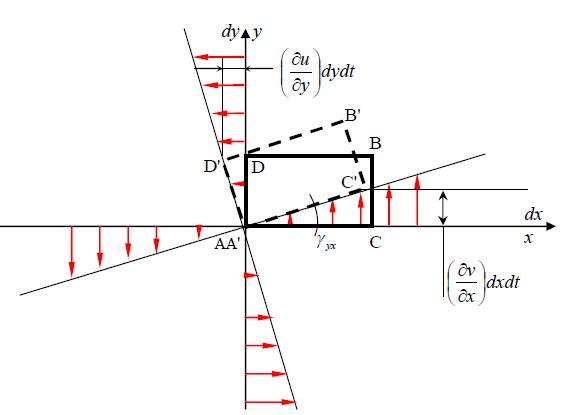Navier-Stokes equations
From CFD-Wiki
(→deformation and rotation) |
(→forces and stresses) |
||
| Line 103: | Line 103: | ||
\begin{array}{c} | \begin{array}{c} | ||
\rho \left( \frac{\partial u}{ \partial t} + u \frac{ \partial u}{ \partial x} + v \frac{ \partial u}{ \partial y} + w \frac{ \partial u}{ \partial z} \right) = \rho F_{x} + \frac{ \partial p_{xx}}{\partial x} + \frac{ \partial p_{yx}}{\partial y} + \frac{ \partial p_{zx}}{\partial z} \\ | \rho \left( \frac{\partial u}{ \partial t} + u \frac{ \partial u}{ \partial x} + v \frac{ \partial u}{ \partial y} + w \frac{ \partial u}{ \partial z} \right) = \rho F_{x} + \frac{ \partial p_{xx}}{\partial x} + \frac{ \partial p_{yx}}{\partial y} + \frac{ \partial p_{zx}}{\partial z} \\ | ||
| - | \rho \left( \frac{\partial u}{ \partial t} + u \frac{ \partial u}{ \partial x} + v \frac{ \partial u}{ \partial y} + w \frac{ \partial u}{ \partial z} \right) = \rho F_{ | + | \rho \left( \frac{\partial u}{ \partial t} + u \frac{ \partial u}{ \partial x} + v \frac{ \partial u}{ \partial y} + w \frac{ \partial u}{ \partial z} \right) = \rho F_{y} + \frac{ \partial p_{xx}}{\partial x} + \frac{ \partial p_{yx}}{\partial y} + \frac{ \partial p_{zx}}{\partial z} \\ |
| - | \rho \left( \frac{\partial u}{ \partial t} + u \frac{ \partial u}{ \partial x} + v \frac{ \partial u}{ \partial y} + w \frac{ \partial u}{ \partial z} \right) = \rho F_{ | + | \rho \left( \frac{\partial u}{ \partial t} + u \frac{ \partial u}{ \partial x} + v \frac{ \partial u}{ \partial y} + w \frac{ \partial u}{ \partial z} \right) = \rho F_{z} + \frac{ \partial p_{xx}}{\partial x} + \frac{ \partial p_{yx}}{\partial y} + \frac{ \partial p_{zx}}{\partial z} \\ |
\end{array} | \end{array} | ||
\right\} | \right\} | ||
Revision as of 13:08, 25 August 2011
The Navier-Stokes equations are the basic governing equations for a viscous, heat conducting fluid. It is a vector equation obtained by applying Newton's Law of Motion to a fluid element and is also called the momentum equation. It is supplemented by the mass conservation equation, also called continuity equation and the energy equation. Usually, the term Navier-Stokes equations is used to refer to all of these equations.
Contents |
History
Claude Louis Marie Henri Navier’s name is associated with the famous Navier-Stokes equations that govern motion of a viscous fluid. He derived the Navier-Stokes equations in a paper in 1822. His derivation was however based on a molecular theory of attraction and repulsion between neighbouring molecules. Euler had already derived the equations for an ideal fluid in 1755 which did not include the effects of viscosity. Navier did not recognize the physical significance of viscosity and attributed the viscosity coefficient to be a function of molecular spacing.
The equations of motion were rederived by Cauchy in 1828 and by Poisson in 1829. In 1843 Barre de Saint-Venant published a derivation of the equations that applied to both laminar and turbulent flows. However the other person whose name is attached with Navier is the Irish mathematician-physicist George Gabriel Stokes. In 1845 he published a derivation of the equations in a manner that is currently understood.
Derivation of continuity equation
Derivation of momentum equations
Expansion, rotation and deformation of a fluid parsel
forces and stresses
|
| (2) |
|
| (3) |
where
 - mass force per volume unit
- mass force per volume unit
 - surface force per volume unit
- surface force per volume unit
|
| (4) |
There are two types of forces: body(mass) forces and surface forces. Body forces act on the entire control volume. The most common body force is that due to gravity. Electromagnetic phenomena may also create body forces, but this is a rather specialized situation.
Surface forces act on only surface of a control volume at a time and arise due to pressure or viscous stresses.
We find a general expression for the surface force per unit volume of a deformable body. Consider a rectangular parallelepiped with sides  and hence with volume
and hence with volume 
At the moment we assume this parallelepiped isolated from the rest of the fluid flow , and consider the forces acting on the faces of the parallelepiped.
Let the left forward top of a parallelepiped lies in a point O
To both faces of the parallelepiped perpendicular to the axis  and having the area
and having the area  applied resulting stresses , equal to
applied resulting stresses , equal to  and
and  respectively
respectively
So we have
for  - direction
- direction 
for  - direction
- direction 
for  - direction
- direction 
|
| (6) |
|
| (7) |
|
| (8) |
|
| (9) |
The force due to the stress is the product of the stress and the area over which it acts.
|
| (10) |
|
| (11) |
|
| (12) |
|
| (13) |
|
| (14) |
deformation and rotation
|
| (15) |
|
| (16) |
|
| (18) |
|
| (19) |
|
| (20) |
|
| (21) |
|
| (11) |
|
| (22) |
Newtonian Fluids
Newton came up with the idea of requiring the stress  to be linearly proportional to the time rate at which at which strain occurs. Specifically he studied the following problem. There are two flat plates separated by a distance
to be linearly proportional to the time rate at which at which strain occurs. Specifically he studied the following problem. There are two flat plates separated by a distance  . The top plate is moved at a velocity
. The top plate is moved at a velocity  , while the bottom plate is held fixed.
, while the bottom plate is held fixed.
Newton postulated (since then experimentally verified) that the shear force or shear stress needed to deform the fluid was linearly proportional to the velocity gradient:
|
| (2) |
The proportionality factor turned out to be a constant at moderate temperatures, and was called the coefficient of viscosity,  . Furthermore, for this particular case, the velocity profile is linear, giving
. Furthermore, for this particular case, the velocity profile is linear, giving  .
.
Therefore, Newton postulated:
|
| (2) |
Fluids that have a linear relationship between stress and strain rate are called Newtonian fluids. This is a property of the fluid, not the flow. Water and air are examples of Newtonian fluids, while blood is a non-Newtonian fluid.
Stokes Hypothesis
Stokes extended Newton's idea from simple 1-D flows (where only one component of velocity is present) to multidimensional flows. He developed the following relations, collectively known as Stokes relations
|
| (12) |
|
| (12) |
|
| (12) |
|
| (12) |
|
| (12) |
|
| (12) |
The quantity  is called molecular viscosity, and is a function of temperature.
is called molecular viscosity, and is a function of temperature.
The coefficient  was chosen by Stokes so that the sum of the normal stresses
was chosen by Stokes so that the sum of the normal stresses  ,
, and
and  are zero.
are zero.
Then
|
| (12) |
substitution
|
| (12) |
Derivation of the energy equation
Equations
The instantaneous continuity equation (1), momentum equation (2) and energy equation (3) for a compressible fluid can be written as:
|
| (1) |
|
| (2) |
|
| (3) |
For a Newtonian fluid, assuming Stokes Law for mono-atomic gases, the viscous stress is given by:
|
| (4) |
Where the trace-less viscous strain-rate is defined by:
|
| (5) |
The heat-flux,  , is given by Fourier's law:
, is given by Fourier's law:
|
| (6) |
Where the laminar Prandtl number  is defined by:
is defined by:
|
| (7) |
To close these equations it is also necessary to specify an equation of state. Assuming a calorically perfect gas the following relations are valid:
|
| (8) |
Where  ,
,  ,
,  and
and  are constant.
are constant.
The total energy  is defined by:
is defined by:
|
| (9) |
Note that the corresponding expression (15) for Favre averaged turbulent flows contains an extra term related to the turbulent energy.
Equations (1)-(9), supplemented with gas data for  ,
,  ,
,  and perhaps
and perhaps  , form a closed set of partial differential equations, and need only be complemented with boundary conditions.
, form a closed set of partial differential equations, and need only be complemented with boundary conditions.
Boundary conditions
Existence and uniqueness
The existence and uniqueness of classical solutions of the 3-D Navier-Stokes equations is still an open mathematical problem and is one of the Clay Institute's Millenium Problems. In 2-D, existence and uniqueness of regular solutions for all time have been shown by Jean Leray in 1933. He also gave the theory for the existence of weak solutions in the 3-D case while uniqueness is still an open question.
However, recently, Prof. Penny Smith submitted a paper, Immortal Smooth Solution of the Three Space Dimensional Navier-Stokes System, which may provide a proof of the existence and uniqueness.(It has a serious flaw, so the author withdrew the paper)
References
C. L. M. H. Navier (1822), "Memoire sur les lois du mouvement des fluides", Mem. Acad. Sci. Inst. France, 6, 389-440.






































![\left.
\begin{array}{c}
\rho \frac{du}{dt} = \rho F_{x}- \frac{\partial p}{ \partial x} + 2 \frac{\partial}{ \partial x} \left( \mu \frac{ \partial u }{ \partial x } \right) + \frac{\partial }{ \partial y} \left[ \mu \left( \frac{\partial u}{ \partial y} + \frac{\partial v}{ \partial x} \right)\right] + \frac{\partial }{ \partial z} \left[ \mu \left( \frac{\partial u}{ \partial z} + \frac{\partial w}{ \partial x} \right)\right] - \frac{2}{3} \frac{\partial}{\partial x}\left( \mu div \textbf{V}\right)\\
\rho \frac{dv}{dt} = \rho F_{y} - \frac{\partial p}{ \partial y} + \frac{\partial }{ \partial x} \left[ \mu \left( \frac{\partial u}{ \partial y} + \frac{\partial v}{ \partial x} \right)\right] + 2 \frac{\partial}{ \partial y} \left( \mu \frac{ \partial v }{ \partial y } \right) + \frac{\partial }{ \partial z} \left[ \mu \left( \frac{\partial v}{ \partial z} + \frac{\partial w}{ \partial y} \right)\right] - \frac{2}{3} \frac{\partial }{ \partial y} \left( \mu div \textbf{V} \right) \\
\rho \frac{dw}{dt} = \rho F_{z} - \frac{\partial p}{ \partial z}+ \frac{\partial }{ \partial x} \left[ \mu \left( \frac{\partial u}{ \partial z} + \frac{\partial w}{ \partial x} \right)\right] + \frac{\partial }{ \partial y} \left[ \mu \left( \frac{\partial v}{ \partial z} + \frac{\partial w}{ \partial y} \right)\right] + 2 \frac{\partial}{ \partial z} \left( \mu \frac{ \partial w }{ \partial z } \right) - \frac{2}{3} \frac{\partial }{ \partial z} ( \mu div \textbf{V} ) \\
\end{array}
\right\}](/W/images/math/f/3/c/f3c81e7c700ed8cdd9655e9b89f6362d.png)
![\frac{\partial \rho}{\partial t} +
\frac{\partial}{\partial x_j}\left[ \rho u_j \right] = 0](/W/images/math/0/7/1/071e4f5508fd336ddad848551ce3188e.png)
![\frac{\partial}{\partial t}\left( \rho u_i \right) +
\frac{\partial}{\partial x_j}
\left[ \rho u_i u_j + p \delta_{ij} - \tau_{ji} \right] = 0, \quad i=1,2,3](/W/images/math/a/b/1/ab156ace613d48ef91f8457e27a51aad.png)
![\frac{\partial}{\partial t}\left( \rho e_0 \right) +
\frac{\partial}{\partial x_j}
\left[ \rho u_j e_0 + u_j p + q_j - u_i \tau_{ij} \right] = 0](/W/images/math/8/1/7/8176cdf87a72617542883cbbeafc50cc.png)





